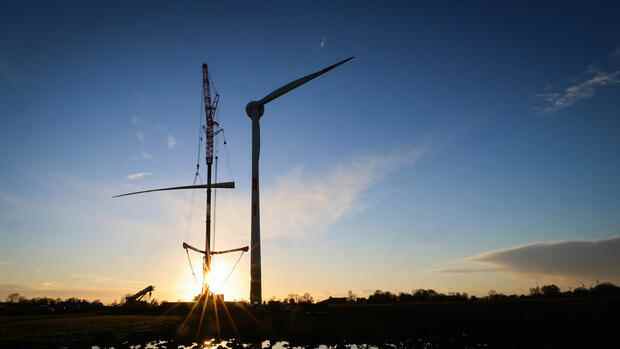Europe must almost double the pace of its expansion in order to achieve the goals it has set itself.
(Photo: dpa)
Dusseldorf Two factories in Spain, one factory in East Germany, three productions in Denmark. In the past twelve months alone, the three largest European wind turbine manufacturers Vestas, Siemens Gamesa and Nordex have laid off more than 1,000 employees. More could follow soon if the rumors about plant closures by the Hamburg Nordex Group should come true in the coming days. The bankruptcies of numerous suppliers are not even included.
Despite billions in order books, the European wind industry is in danger of withdrawing more and more from domestic value creation. According to Giles Dickson, head of the European association Wind Europe, the reasons for this are obvious: “In order to remain competitive, the industry needs larger quantities. And we also need them for Europe.”
Wind Europe presented the latest expansion figures this Thursday. The result is sobering. Just 17 gigawatts of new wind power was installed in 2021. 80 percent of it on land. In order to achieve its climate goals for 2030, however, the European Union needs more than twice as many new wind turbines – per year. And especially at sea.
“The expansion of wind power is progressing far too slowly. This is mainly due to the fact that the approval procedures in all countries, not just in Germany, take far too long,” criticizes Dickson.
Top jobs of the day
Find the best jobs now and
be notified by email.
EU requirements are not implemented
The EU had already clearly stipulated in 2018 with the RED II (Renewable Energy Directive) that approval procedures for renewable systems must be available within a maximum of two years. The deadline for implementation expired in summer 2021.
In reality, things are different in many countries. Example Germany: Approvals for a wind farm usually take four to five years. With offshore wind power at sea, which will be so important in the future, it often takes even longer.
For years, the expansion in what was once the world’s largest wind market has hardly progressed. Although Germany is still one of the countries with the most wind turbines today, China, the USA and Brazil now lead the global market in terms of new installations. As a result, the European world market leaders Vestas, Siemens Gamesa and Nordex are relocating more and more production facilities abroad.
In Germany alone, more than 60,000 jobs have been lost in the wind industry in the last ten years. Germany, once the most important sales market for Nordex, only manages seventh place in the 2020 annual report and is behind the USA, Turkey, Brazil and Argentina, among others.
“We are very worried because more and more wind industry is moving away from Germany. But with Robert Habeck’s Easter package, we will already get many changes under way,” says SPD MP Bengt Bergt, member of the Committee on Climate Protection and Energy. Before moving into the Bundestag until the end of last year, Bergt was also Deputy Chairman of the Nordex Group Works Council.
With the so-called “Easter Package” of the Economics Minister, the new federal government wants to develop more areas for wind power in the short term. In addition, the distances to rotary radio beacons and weather radars are to be shortened. The last two points alone could raise a potential of up to nine gigawatts of power.
“Germany has made good progress in solving its problems. And with the new federal government, things should get even better, and the approval procedures should also be simplified,” Dickson also acknowledges. There is definitely more political will, but currently almost all wind companies are working with losses. That has to change.
Also, because wind capacities have been distributed via tenders for several years, in which only the cheapest bid is awarded the contract, the price war among manufacturers has intensified massively. “One should be less obsessed with prices and also think about the social added value of a European wind industry,” says the head of the association.
Almost 300,000 people currently work in the wind industry in Europe. In theory, that number could grow to 450,000 by 2030. However, if the expansion does not accelerate, experts not only expect climate targets to be missed, but also the loss of tens of thousands of jobs.
With a view to the price rally for coal, oil and gas, economists, experts and politicians are repeatedly calling for the accelerated expansion of renewable energies in order to free oneself more quickly from dependence on fossil fuels. However, this goal cannot be achieved with the current pace of expansion.
The EU promises improvement. By the summer, the Commission intends to publish guidelines for accelerating the approval procedures in the Member States. “We will create an acceleration,” promised Energy Commissioner Kadri Simson.
More: Energy transition at risk: the climate goals cannot be achieved without specialists



